Translate this page into:
Multi-Wave Punch for Follicular Unit Excision Hair Transplantation Surgery
Address for correspondence: Dr. Jae Hyun Park, Dana Plastic Surgery Clinic, 10F Samju Building, Gangnamdaero 606, Gangnamgu, Seoul 06038, Korea. E-mail: jay8384@naver.com
This article was originally published by Wolters Kluwer - Medknow and was migrated to Scientific Scholar after the change of Publisher.
Abstract
Abstract
Follicular unit excision is widely used for hair transplantation because it lacks a donor scar and is associated with less postoperative pain. Obtaining high-quality grafts and minimizing hair follicle damage during graft harvesting are key. This review elaborates on the types and dynamics of punches used in follicular unit extraction. We also describe the utility and advantages of a new “Multi-Wave Punch,” a new type of punch designed to optimize graft extraction and reduce follicular injury. This multi-wave punch is composed of three different parts. The cutting edge at the end is blunt-angled. Adjacent is the leading edge, which is characterized by several horizontally oriented multi-wave shapes. Most proximal is the main body, which is decagonal in shape. Because of the multi-wave and decagonal structure, the punch easily enters the outer layers of the scalp. The wave energy is transmitted to the surrounding tissue, separating hair follicles from adjacent tissue, facilitating extraction, reducing follicular damage, and ensuring higher quality grafts.
Keywords
Alopecia
follicular unit excision
hair follicle
hair transplant
INTRODUCTION
Hair transplantation is the mainstay of surgical hair loss treatment. It involves harvesting of hair follicles from a donor area that is expected to be free from hair loss and transplanting them into a recipient area affected by alopecia.
Follicular unit strip surgery (FUSS) and follicular unit excision (FUE) are the two primary methods of follicle harvesting. FUE is increasingly being used because it is associated with less pain and lacks a donor scar.[1] This method extracts hair follicles by inserting a rotating cylindrical punch into the skin. It is essentially a blind procedure. The ultimate goal is to obtain hair follicles that are as healthy and intact as possible without transecting the graft or causing other minor injuries.[23]
The scalp is composed of the epidermis, dermis, subcutaneous fat layer, galea aponeurosis, and pericranium.[4] When advancing currently available hair transplant punches into the scalp for FUE, they enter the epidermis, dermis, and subcutaneous layers. However, a punch that efficiently targets each layer is needed.[5]
Here, we present the design, dynamics, and physics of a novel and innovative multi-wave punch. To the best of our knowledge, such a punch has never been described before. We also report our experience with this punch and review the punch literature, and compare the multi-wave punch with other conventional ones.
Graft injury in follicular unit excision procedure
Minimizing the incidence of graft transection when using the FUE method is paramount.[67] Another goal of FUE is extracting “chubby” grafts similar to those obtained with FUSS, as “chubby” grafts are associated with better survival. In 2017, Park and You[2] argued that minor follicular injuries such as paring, fracture, dermal papilla injury, and hair bulb injury exert a negative influence on graft survival and are less frequent with FUE than FUSS. A follow-up study 3 years later showed that grafts with minor follicular injuries had a lower survival rate than intact hair follicles[3] [Figure 1].

- Concept schema for various minor injuries
Therefore, to achieve a high graft survival rate, follicular injuries should be minimized in addition to minimizing the transection rate and extracting “chubby” grafts.
Various follicular unit excision punches
In the early era of FUE, the optimal type of punch to use was controversial and a battle between sharp and blunt. Cole[5] preferred the sharp punch, arguing that axial force should be minimized. Harris[7] advocated a hexagon-shaped blunt punch. Other more advanced punches have been introduced more recently, including the flare-shaped, hybrid trumpet, and edge-out punches [Figure 2].
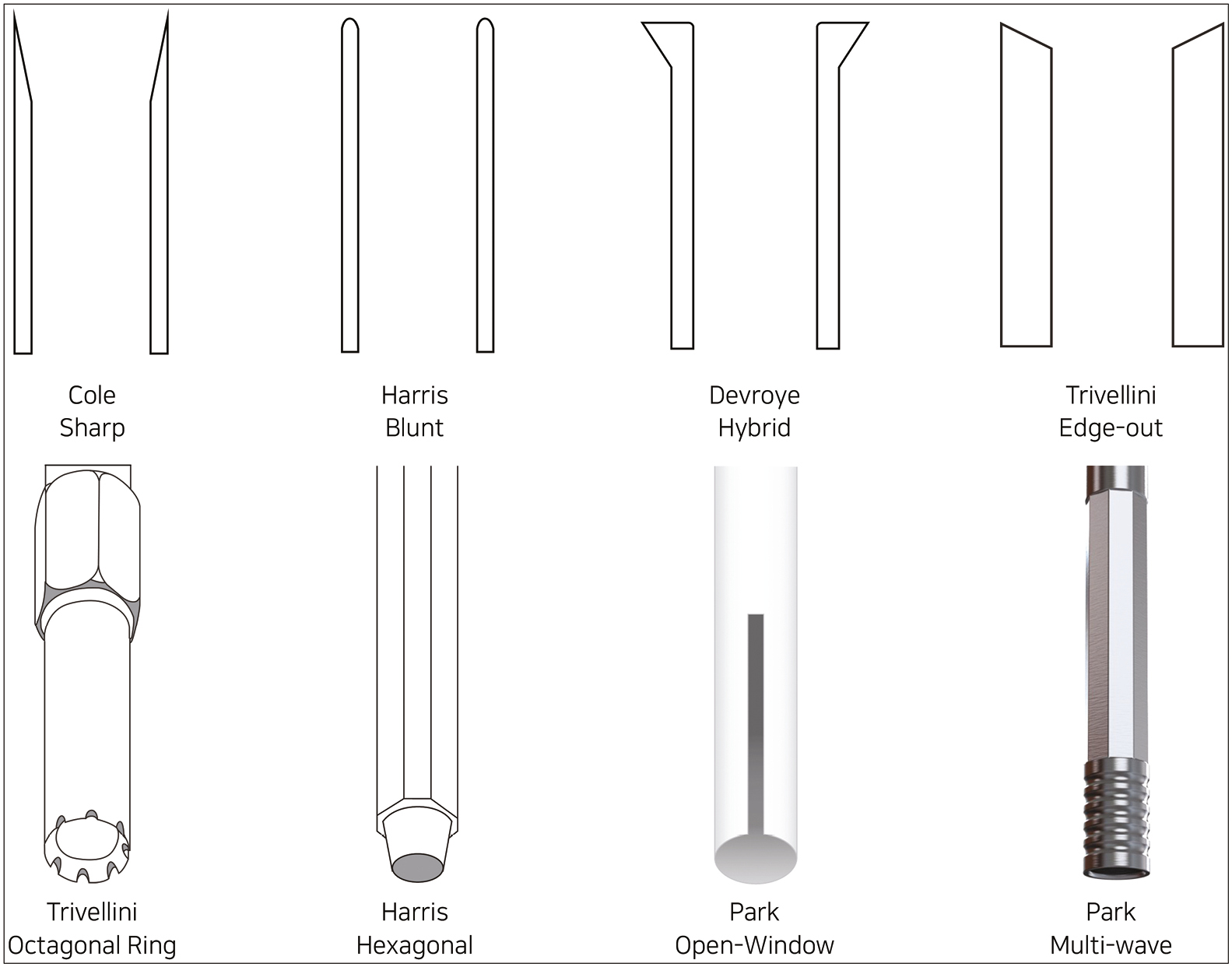
- Various punch shapes for follicular unit excision.
Sharp punch
The sharp punch was designed to lower friction and axial force by reducing the contact surface area between the skin surface and the punch blade. This allows the surgeon to perform harvesting at a very high speed while minimizing the axial force. However, the punching depth (PD) must be shallow to minimize graft transection, which is a major disadvantage of this punch type.
Blunt punch
The blunt punch, represented by Harris’ SAFE (surgically advanced follicular extraction) system, reduces follicular damage owing to the blunt surface of the punch tip edge.[7] This punch can punch deeper than 4 mm. The ARTAS hair restoration robotic system is equipped with a dual punch[8]: initial scoring with the inner sharp punch is followed by deeper dissection with the outer blunt punch.
Flared punch
With the sharp and blunt punches, the cutting axis has the same vector as the punching axis. The cutting end point exists between the inner and outer walls of the punch. With the flared punch, the cutting vector is directed more outward than the sharp and blunt punches and the cutting end point is located further outward than the outer diameter [Figure 3]. This structure reduces follicular injury. Various punches designed by Umar, Trivellini, and Devroye fall in the flared category.[910]

- Cutting vector and cutting end point of various punches
Edge-out punch
The edge-out punch was introduced by Trivellini and allows slight pressure to be applied at the end of the punch through a thicker wall. In addition, the cutting vector is directed slightly outward.[11] However, the cutting end does not face outward beyond the outer diameter. In this case, the outer diameter and the cutting end coincide, and only the cutting vector is directed slightly outward. This type of punch represents an intermediate form between the sharp and flared punches.
Ring punch
Trivellini also introduced an octagonal ring punch based on Harris’ concept.[12] The octagonal shape of the ring increases vibration and facilitates separation of the graft from the wall of the punch. In addition, the distal edge of the punch is blunt and has several notches, which allows excision of both long and shaved hairs using the same punch.
Dynamics and physics of follicular unit excision
Punch angle
According to Rose et al.,[13] the angle of the punch upon skin incision should be approximately 45º on average. As this angle becomes more vertical, the wound surface decreases as does the incidence of follicular injury.[14] The hair exit angle can easily be converted into less acute angles simply by applying upward traction to the scalp or using tumescent injections.[15]
When donor hairs have an extremely acute exit angle, the lower and upper edges of the punch contact the skin at different times, which can cause tissue distortion [Figure 4]. Because of the 360 degree-nature of the punch blade, when the lower edge is dissecting the skin surface, the upper edge still hangs in the air; therefore, the skin is asymmetrically incised only on one side of the punch, depending on the skin characteristics and hair follicle depth. In this case, using a sharp punch or making changes in the punch setting or insertion speed may help prevent follicular damage by reducing the time between lower edge skin contact and upper edge skin contact.
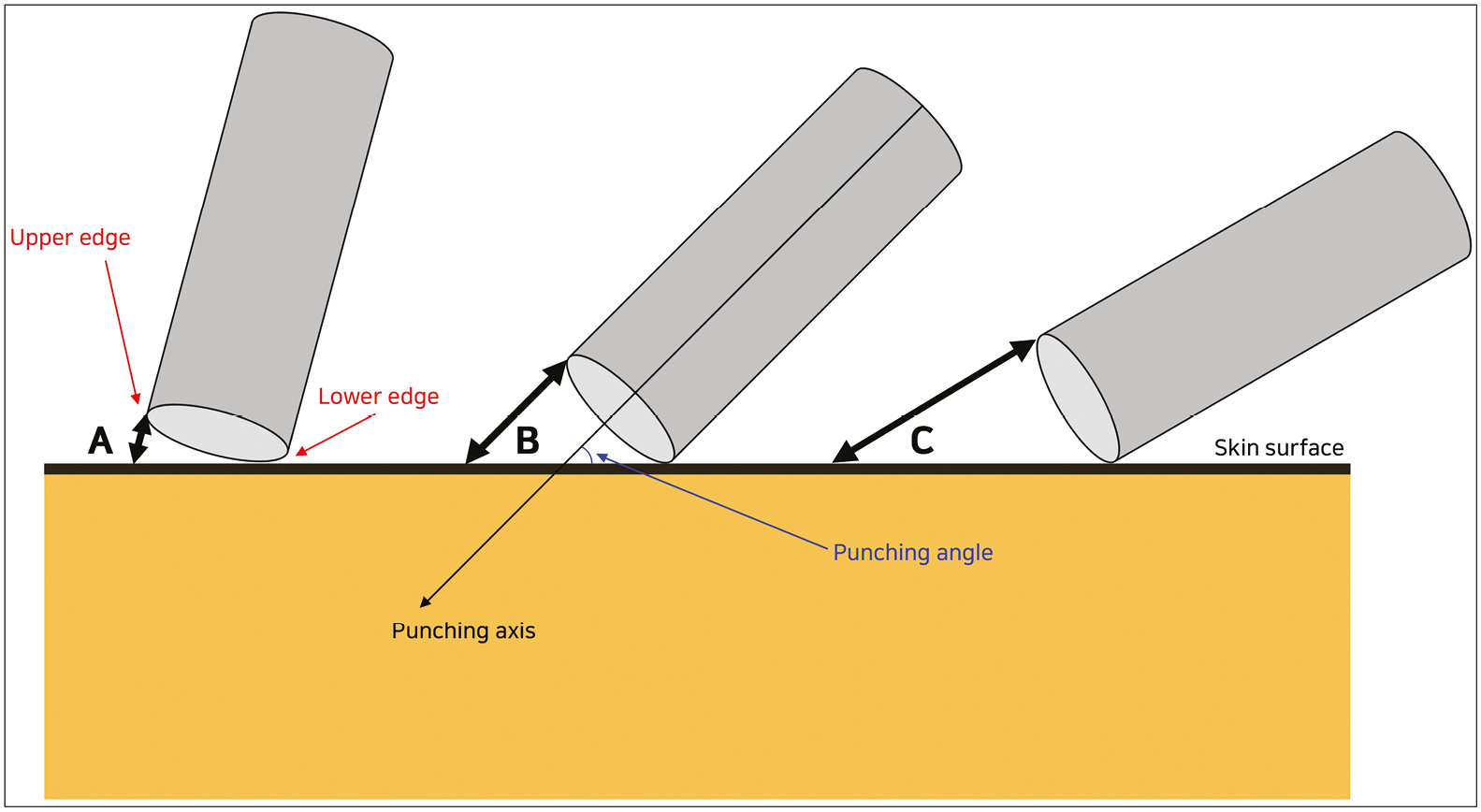
- The lower and upper edges of the punch contact the skin at different times according to the punching angle
When the punch insertion angle is extremely acute or the skin is extremely elastic, use of a punch that is too blunt or flared causes a large skin scoring time difference between the lower and upper ends. This may increase the tendency for graft distortion. Therefore, the cutting time between the two ends should be shortened. The screw effect of the multi-wave punch, which will be described later, plays a role here.
Surgically advanced follicular extraction punching depth
In general, as the PD increases, the amount of perifollicular tissue increases, enabling harvesting of “chubbier” grafts. Conversely, when PD decreases, the amount of perifollicular tissue decreases, as does incidence of graft injury.[16]
If the PD is too shallow, capping or plucking occurs, and the follicle is not extracted. Minimal depth can be reached by advancing slightly deeper, where hair follicles can be successfully extracted. Cole[5] introduced a technique for minimal depth punching using a sharp punch. Park[17] preferred a deeper PD that was able to safely acquire healthy donor grafts atraumatically; he named this depth the safe PD. Advancing deeper than this increases the chance of follicular damage [Figure 5].
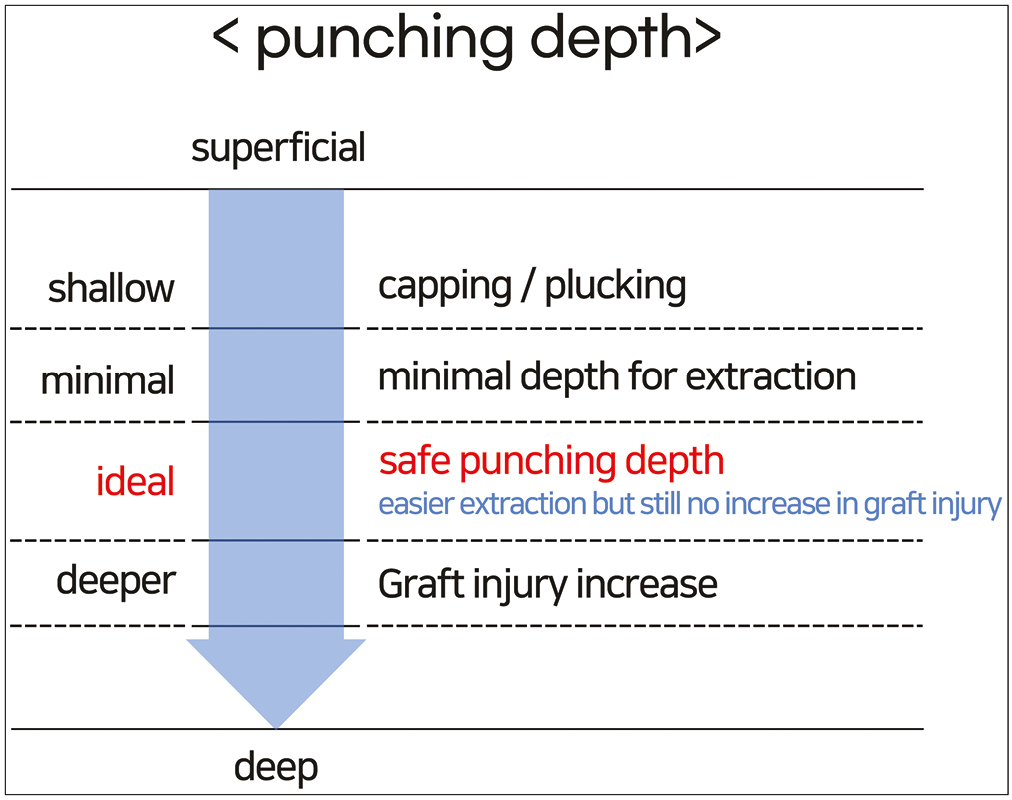
- Concept of safe punching depth
Safe PD is not an absolute value and differs according to the surgeon’s skill, punch type, punch motion, patient characteristics, and punching location in the same patient. Even at the same PD, the vibratory energy generated from the multi-wave punch is transmitted to the surrounding tissue, which widens the gap between the target graft and the surrounding tissue and facilitates graft extraction. In other words, graft harvesting is plausible at a shallower PD.
Punch wall thickness and sharpness
Thickness and sharpness of the punch wall lumen are important punch tip characteristics. In general, the wall thickness of the punch lumen ranges from 0.08 to 0.125 mm; 0.1 mm is most commonly used. The thinner the wall, the faster the tip abrasion; the thicker the wall, the more resistance encountered. The cutting angle of the punch edge can be created at an obtuse or acute angle. At a more obtuse angle, the cutting point remains the same but the cutting vector is directed more laterally, which is advantageous. At a more acute angle, tissue cutting is easier, less axial force is applied, and operation time is reduced; however, the graft transection rate may increase.
The scalp and follicular unit excision punches
A punch tip sequentially penetrates the epidermis, dermis, and subcutaneous layer of the scalp. The galea and pericranium are not penetrated. Because each of these layers has a different density and thickness, the punch tip interacts differently with each one. The outermost epidermis is encountered by the punch tip first. Next, is the dermis, which has a high density. Last is the subcutaneous later, which contains fat and is loosely organized.
Hairs do not exit perpendicular to the skin. The average punch advancing angle in FUE is approximately 45º.[8] Therefore, as the punch tip enters the skin, the layer introduced to its upper edge would never coincide with that introduced to the lower edge. The lower edge first contacts the skin while the upper edge is still hanging in the air without any contact. As the punch tip dissects the skin surface, it will simultaneously stay in three different layers, making a simple act a very complex phenomenon.
The ideal punch would comprise three different parts to efficiently target each of the three scalp layers penetrated. First is the cutting edge, which comprises the first 0.25 mm of the tip and affects the changes and phenomena that occur when the punch first comes into contact with the skin. Second is the leading edge, which rests in the 1.5 mm-long section next to the cutting edge. Its characteristics affect the advancement of the cutting edge through the 1.5–2 mm of dermis. Third is the main body, which is adjacent to the leading edge. This part is responsible for advancement of the cutting and leading edges into the subcutaneous layer.
Likewise, the process of graft dissection can be divided into three sections. Optimally designing the punch shape to generate appropriate changes in motion by each section allows the surgeon to obtain high-quality grafts while minimizing follicular damage.
Dynamics of the multi-wave follicular unit excision punch
The multi-wave punch is designed to bring about the best physical response for successful graft extraction at every entry of the tip into each of the three scalp layers penetrated [Figure 6]. The cutting edge of the punch tip is not entirely sharp. It has a blunt or less acute cutting angle and the ultimate cutting vector is directed outward intermediate to that of the sharp and flared punches (but closer to the latter). Unlike sharp punches, in which the advancing axis and cutting vector almost coincide, the cutting vector is directed more outward, which reduces incidence of follicular injury. Dissimilar to general hybrid flared punches, there is no change in the inner or outer diameter of the punch, and the cutting end diameter corresponds to the outer diameter.
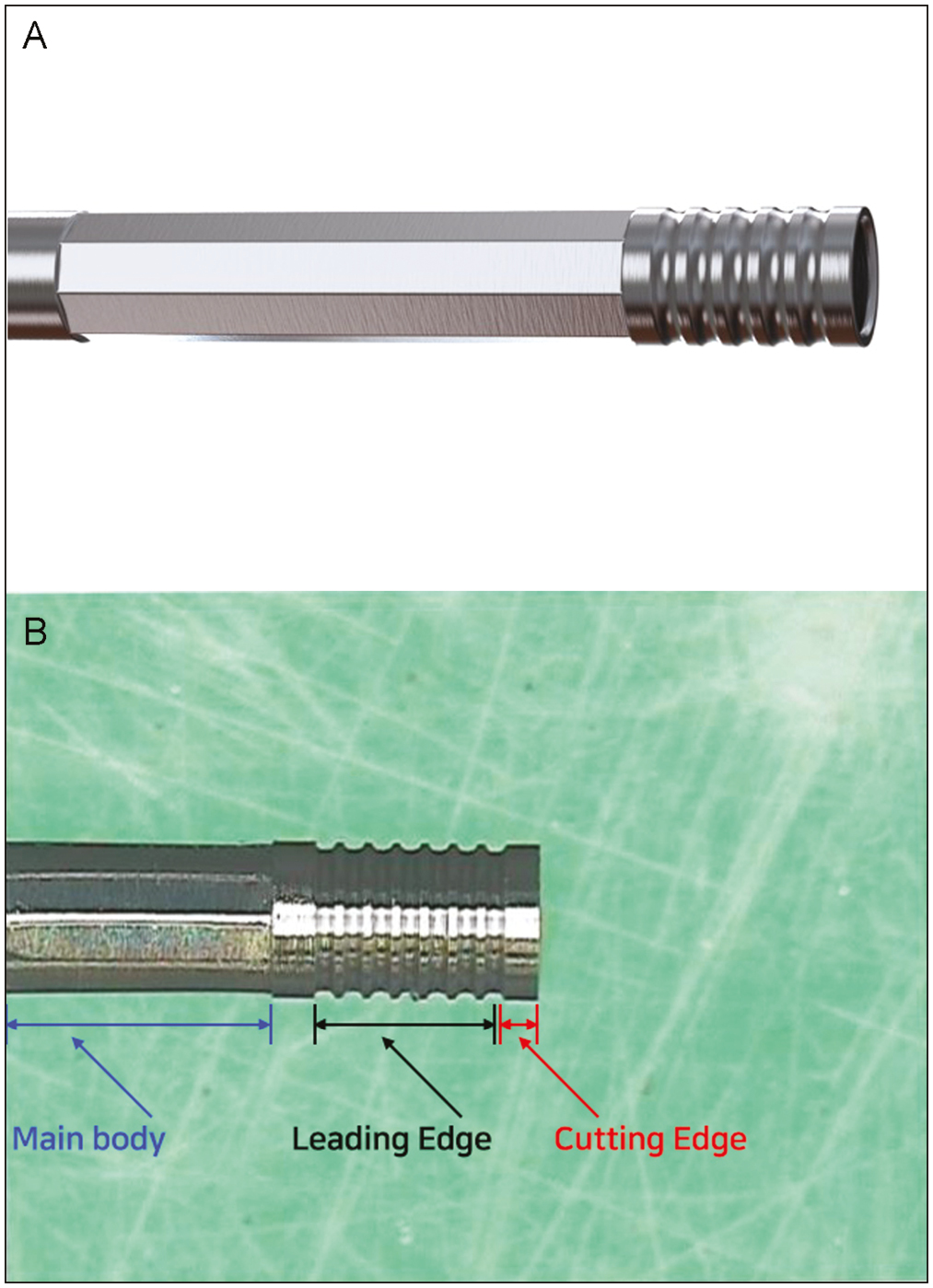
- The multi-wave punch. (A) Three-dimensional image. (B) The three main parts
The leading edge begins 0.25 mm from the tip. Several horizontal waves give rise to small vibratory responses as the punch punctures the skin and advances through the epidermis and dermis. As a result, energy in the form of multiple small waves is created to ease graft dissection. When the punch moves forward, the multi-wave structure, which resembles a spiral screw, readily advances into the skin as if being sucked into the tissue [Figure 7]. Therefore, the dissection is rapid and stable with the feeling of being drawn into the scalp.
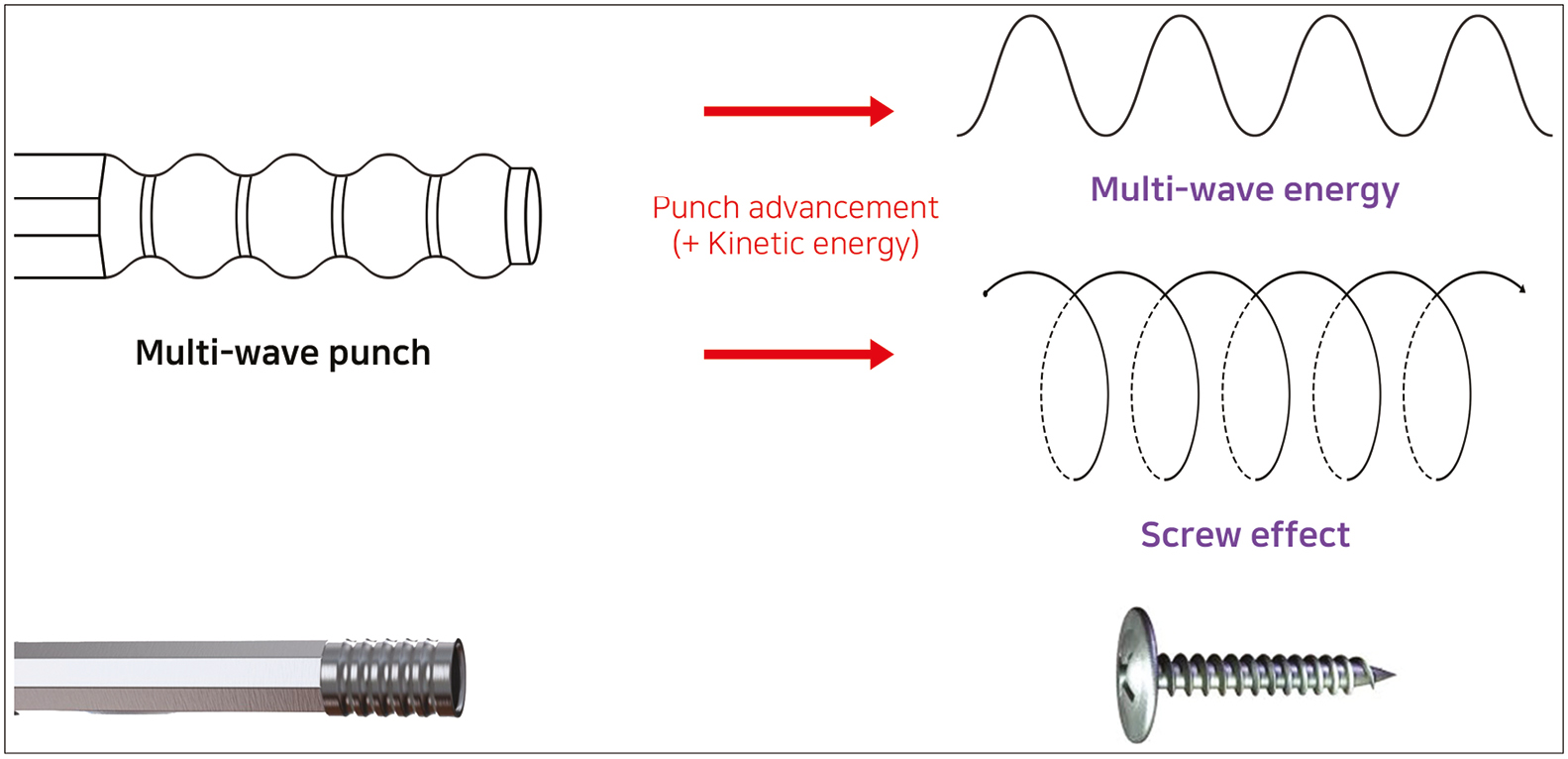
- The relationship between the screw effect and multi-wave energy with the multi-wave punch
The decagon-shaped main body enters the epidermis and dermis when the end of the punch starts to enter the subcutaneous layer. Rotating or oscillating, the decagonal structure causes a vibratory action in the surrounding tissue. This naturally propagates energy in a radial wave from the punch tip to the surrounding tissue, allowing easier separation from the target graft. The cutting edge cuts the skin, and at the same time, the above energy wave is transmitted to the surrounding tissue to enable easier extraction.
CONCLUSION
Various punches for FUE have been introduced, each with its own advantages and disadvantages. The dynamics of the multi-wave punch can be divided into three sections: scalp contact and skin incision, traversing the epidermis and dermis, and subcutaneous dissection. The multi-wave punch was structurally designed with these dynamics in mind to minimize follicular damage during graft harvesting.
Financial disclosure statement
Dr. J.H. Park has patents and ownership interest of Seson medical company.
For the remaining authors none were declared. No funding was received for this article.
Conflicts of interest
There are no conflicts of interest.
Acknowledgment
We thank Edanz (https://jp.edanz.com/ac) for editing a draft of this manuscript.
References
- Comparison of postoperative pain according to the harvesting method used in hair restorative surgery. Arch Plast Surg. 2019;46:241-7.
- [Google Scholar]
- Various types of minor trauma to hair follicles during follicular unit extraction for hair transplantation. Plast Reconstr Surg Glob Open. 2017;5:e1260.
- [Google Scholar]
- Comparative graft survival study of follicular unit excision grafts with or without minor injury. Dermatol Surg. 2021;47:e191-4.
- [Google Scholar]
- The surgical anatomy of the scalp. Plast Reconstr Surg. 1991;87:603-12. discussion 613-4
- [Google Scholar]
- An analysis of follicular punches, mechanics, and dynamics in follicular unit extraction. Facial Plast Surg Clin North Am. 2013;21:437-47.
- [Google Scholar]
- Transection rate at different areas of scalp during follicular unit extraction/excision (FUE) J Cosmet Dermatol. 2020;19:1705-8.
- [Google Scholar]
- New methodology and instrumentation for follicular unit extraction: Lower follicle transection rates and expanded patient candidacy. Dermatol Surg. 2006;32:56-61. discussion 61-2
- [Google Scholar]
- A novel follicular unit excision device for all-purpose hair graft harvesting. Clin Cosmet Investig Dermatol. 2021;14:1657-74.
- [Google Scholar]
- Innovations hair restoration surgeons have made to adapt to the challenges of follicular unit excision. J Cosmet Dermatol. 2020;19:1883-91.
- [Google Scholar]
- The edge out punch: An advancement that reduces transections in follicular unit excision hair transplantation. J Cosmet Dermatol. 2020;19:2194-200.
- [Google Scholar]
- Hair transplantation follicular unit excision (FUE): Introducing the multipurpose octagonal ring punch. J Cosmet Dermatol. 2021;20:2602-5.
- [Google Scholar]
- Examination of the exit angle of hair at the skin surface versus the internal angle of hair as it relates to the FUE/FIT harvesting method. Hair Forum Int’l. 2017;27:8-10.
- [Google Scholar]
- Minimizing injury to the donor area in follicular unit extraction (FUE) harvesting. J Cosmet Dermatol. 2017;16:61-9.
- [Google Scholar]
- Forehead-supporting chair system for follicular unit extraction hair transplantation. Arch Aesthetic Plast Surg. 2019;25:42-4.
- [Google Scholar]
- Depth control in follicular unit excision: A new classification from a detailed analysis of 30 patients undergoing FUE technique for hair restoration. J Cosmet Dermatol. 2022;21:5977-83.
- [Google Scholar]
- FUE round table questions and answers. Hair Transplant Forum Int’l. 2016;26:139-40.
- [Google Scholar]






